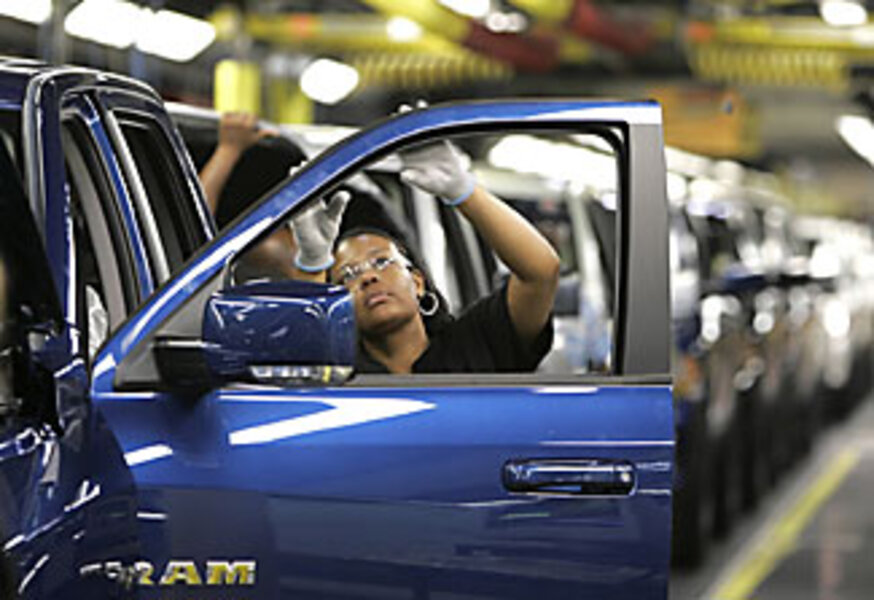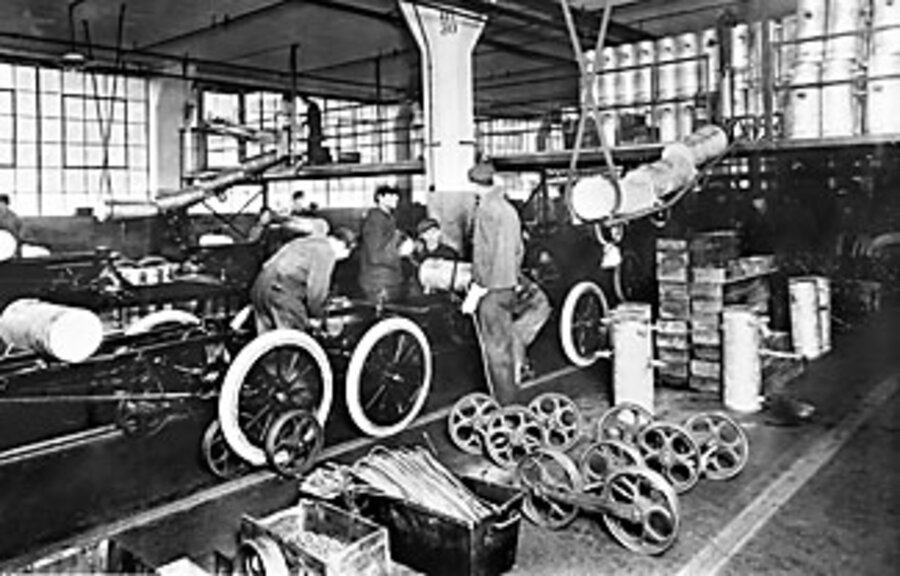Automakers' recovery plan: Get small.
Loading...
| Washington
The US auto industry – a pillar of America's industrial might for 100 years – appears headed toward the most wrenching change it has ever experienced.
That may be the underlying message of the business plans submitted by General Motors, Ford, and Chrysler to Congress this week as part of Detroit's desperate effort to win a government bailout.
As shown by figures contained in the plans, if Washington doesn't provide aid, GM and Chrysler are almost certain to go bankrupt. If lawmakers do approve a rescue, these venerable firms promise they will slash operations like never before as they struggle to return to profitability.
Whatever US political leaders decide, the very phrase "Big Three" could soon be obsolete, as Detroit shrinks and perhaps consolidates.
"They're talking about getting smaller, but they really have no choice but to do that," says Clifford Winston, a Brookings Institution economist who has researched the US auto industry's market share.
Auto companies' CEOs are making the rounds in Washington this week as they attempt a second time to get lawmakers to approve an auto industry bailout.
Their first attempt last month was widely panned. Lawmakers said the executives appeared less than contrite about past missteps. They complained that the heads of GM, Ford, and Chrysler all flew to D.C. on separate private jets.
This time, the supplicants from Detroit have ditched the jets for hybrid vehicles and driven to the nation's capital. They've replaced their vague pleas for help with lengthy plans about how they'd use federal money.
These blueprints were delivered Tuesday to Capitol Hill, and the financial situation they revealed is dire. GM and Chrysler both say that without an infusion of cash they won't last through the holiday season.
GM says it needs $4 billion in taxpayer funds right away, plus a $6 billion line of credit. Chrysler says it must have $7 billion or it will go bankrupt by year's end. Ford is in a better financial position but asked for a $9 billion standby line of credit it could draw on in case one of its competitors goes under.
GM's plan states that the firm is already losing sales as a result of customer fears of its possible bankruptcy. In dire language, the plan warns that such a collapse could trigger "catastrophic" economic damage, costing the United States as many as 3 million jobs.
The "bankruptcy of an auto company [would be] markedly different and much riskier than that of a steel company or airline," insists the GM plan.
Figures contained in GM's outline indicate the firm plans to reduce hourly and salaried employees from today's level of about 96,000 to between 65,000 and 75,000 by 2012.
Dealer locations will be slashed from 6,450 to 4,700 over the same period, according to the plan. Only four core brands will remain: Chevrolet, Cadillac, Buick, and GMC.
Ford plans workforce cuts, too
Ford, for its part, noted it has already announced plans to cut about 10 percent of its North American salaried workforce of 22,600. Overall cuts in operating costs for 2009 will reach $1 billion, Ford said.
Chrysler, a privately held firm, said it would produce its first full-function electric vehicle by 2010 and expects to pump out more than 500,000 such cars by 2013.
High-stakes congressional hearings Dec. 4 and 5 will examine the automakers' plans, as lawmakers decide what to do. Democratic leaders have voiced concern about the industry's plight but have made no commitments.
"It is my hope that we would" pass auto rescue legislation, House Speaker Nancy Pelosi said late Tuesday.
Striking by its absence in the auto plans is a recognition of what Detroit's long-term problem really is – the appeal of the products, says Mr. Winston of the Brookings Institution in Washington.
The Big Three have lost market share because foreign firms have beat them with a ground game: products that offer better basic attributes, such as price, power, reliability, and styling, according to a paper in the International Economic Review co-authored by Winston.
Just offering more US-made hybrids won't save the industry, in Winston's view. Detroit has to make better hybrids – and those from Japan are already pretty good.
"Economics have nothing to do with this," he says.
How to get the union to go along?
The plans assert that Detroit will reach labor cost competitiveness with foreign competitors by 2012. But they don't say how they will get the United Auto Workers to accept the deep pay cuts needed to reach that goal, says Peter Morici, a University of Maryland economist and professor of business who appeared on a panel with the auto CEOs at last month's congressional hearings.
Even if GM can reduce its dealership numbers to 4,700 – a doubtful proposition – that's still too many, says Mr. Morici. Honda, for its part, has 1,300 US dealerships.
GM says it will focus on four brands, but the fine print in its plan says models will be reduced only from today's 48 nameplates to 40 by 2012.
"The GM plan is a fantasy," says Morici.
Still, both Morici and Winston predict that Washington will approve some kind of auto assistance. "I'll be amazed if they don't," says Winston.






